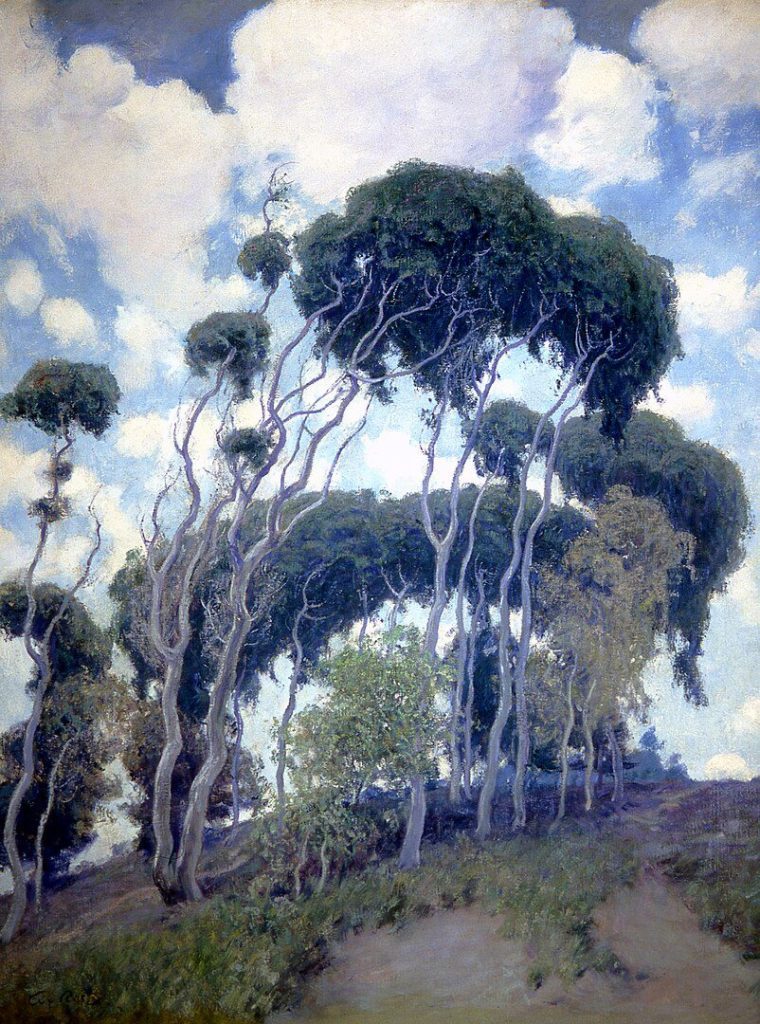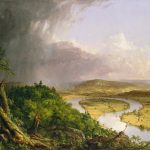
California Impressionism was a radiant and distinctive regional art movement that flourished between the late 19th and early 20th centuries. Emerging as an offshoot of French Impressionism, it captured the brilliant light, expansive landscapes, and rich colors of the Golden State. Unlike the moodier, subdued palettes of East Coast painters, California Impressionists embraced the region’s year-round sunshine, creating works that radiated warmth and vibrancy. Their paintings offered a stunning celebration of California’s coastlines, mountains, and rolling hills, cementing the movement’s place in American art history.
The movement took root as California’s art scene evolved and painters sought to break free from academic traditions. Many artists traveled to Europe to study Impressionism firsthand, returning with new techniques and a fresh appreciation for plein-air (outdoor) painting. While they admired the innovations of Claude Monet and Pierre-Auguste Renoir, these artists adapted Impressionist principles to the rugged beauty of the American West. Their work reflected not only the region’s breathtaking scenery but also a growing cultural identity that set California apart from the rest of the country.
Urbanization and rapid development in California during this period also played a key role in shaping the movement. Artists felt an urgency to document the state’s pristine landscapes before they were altered by industrial expansion. Through their canvases, they preserved the beauty of untouched valleys, wildflower meadows, and dramatic shorelines. Their paintings became both a testament to nature’s splendor and a call to appreciate the land’s fleeting, delicate qualities.
This article will explore the origins of California Impressionism, highlighting the key figures, techniques, and communities that defined it. By delving into its rise, decline, and eventual revival, we will uncover why this movement remains a vital and cherished part of America’s artistic legacy. Through the work of pioneering artists, California Impressionism continues to inspire painters, collectors, and nature lovers alike.
The Birth of California Impressionism
The late 19th century marked a period of artistic transformation in California as painters sought to establish a distinct visual identity for the West Coast. While the East Coast art world remained influenced by the dark tonalities of the Hudson River School and European academic realism, California artists embraced a lighter, more expressive style. Impressionism, with its emphasis on capturing fleeting moments through quick brushstrokes and luminous colors, provided the perfect artistic vehicle for depicting California’s breathtaking scenery. As a result, a new school of painters emerged, eager to portray the landscapes around them in fresh and vibrant ways.
The roots of California Impressionism can be traced back to European influences, particularly French Impressionism and the Barbizon School. Artists such as Claude Monet, Camille Pissarro, and Jean-Baptiste-Camille Corot had revolutionized landscape painting with their plein-air techniques and focus on natural light. Many American painters traveled to France in the late 1800s, where they absorbed these new ideas. Institutions like the Académie Julian in Paris became training grounds for American artists, who later returned to California and adapted these methods to local landscapes.
Several art schools and institutions played a vital role in spreading Impressionism in California. The California School of Design, established in San Francisco in 1874, became one of the earliest centers of Impressionist instruction. Other institutions, including the Los Angeles School of Art and Design and the Chouinard Art Institute, provided rigorous training for aspiring artists. These schools not only taught European techniques but also encouraged students to experiment with new styles, helping to shape the emerging California Impressionist movement.
By the turn of the 20th century, Impressionism had taken firm root in California, with artists forming communities dedicated to this new artistic vision. Painters gathered in scenic locations to work outdoors, capturing the landscape with bold, expressive brushstrokes. They sought to depict not just the physical beauty of California but also the fleeting effects of light and atmosphere. This period marked the beginning of a flourishing movement that would continue to evolve over the coming decades, solidifying its place in American art.
Key Artists of the California Impressionist Movement
Among the most influential artists in California Impressionism was Guy Rose (1867–1925), who was born in San Gabriel, California. Rose studied in Paris and became deeply influenced by Claude Monet’s use of light and color. After returning to California, he painted stunning coastal scenes, particularly in Laguna Beach and Carmel. His work remains among the finest examples of California Impressionism, embodying the movement’s emphasis on luminous, atmospheric landscapes.
Another leading figure was William Wendt (1865–1946), a German-born artist who immigrated to the United States and later settled in California. Known as the “Dean of Southern California Painters,” Wendt specialized in grand, sweeping landscapes that captured the untouched beauty of the West. His thick, expressive brushstrokes and vibrant color palettes reflected a deep reverence for nature. Wendt was also a co-founder of the California Art Club in 1909, an organization that played a crucial role in promoting Impressionist art in the region.
Edgar Payne (1883–1947) was renowned for his dramatic depictions of the Sierra Nevada mountains and other rugged landscapes. Payne’s large-scale plein-air compositions often featured intense color contrasts and dynamic movement, setting his work apart from other Impressionists. He traveled extensively throughout the West, painting the cliffs of the Grand Canyon and the peaks of the Rockies. His 1941 book, Composition of Outdoor Painting, remains an essential guide for artists interested in plein-air techniques.
One of the most unique artists in the movement was Granville Redmond (1871–1935), who lost his hearing as a child due to scarlet fever. Despite this challenge, he became one of the most beloved California Impressionists, known for his breathtaking wildflower paintings. His vibrant poppy fields and rolling meadows captured the delicate beauty of the California spring. Redmond was also a close friend of Charlie Chaplin, who admired his artistic talent and even included him in several silent films.
The Role of Plein-Air Painting and California’s Unique Light
Plein-air painting was central to California Impressionism, allowing artists to capture the effects of natural light in real time. Unlike studio-based painting, plein-air work emphasized spontaneity, movement, and direct observation of the landscape. This approach was perfectly suited to California’s diverse scenery, which ranged from rugged mountains to sunlit beaches. Painters took advantage of the state’s ideal climate, working outdoors year-round to create immersive and dynamic compositions.
One of the defining characteristics of California Impressionism was its use of bright, warm colors to reflect the region’s distinctive light. Unlike the cooler tones favored by French Impressionists, California painters embraced golden hues, deep blues, and vibrant greens. The state’s abundant sunshine created strong contrasts and a sense of luminosity that made landscapes appear almost glowing. Artists carefully studied the way light interacted with different surfaces, from the shimmering ocean waves to the dappled shadows beneath eucalyptus trees.
The movement’s approach to brushwork also reflected the energy and vibrancy of the natural world. California Impressionists applied paint in thick, textured strokes to suggest movement, whether it was wind blowing through the hills or waves crashing against the shore. This technique gave their paintings a lively, expressive quality that distinguished them from the more delicate approach of European Impressionists. The goal was not to create a precise, detailed representation but rather to capture the mood and essence of a scene.
Beyond technique, plein-air painting also fostered a deep emotional connection between artists and the land. Many Impressionists saw California as a paradise, an untouched haven of natural beauty, and their paintings reflected this idealized vision. Their work not only celebrated the grandeur of the landscape but also served as a response to the growing encroachment of urbanization. In this way, California Impressionism became both a tribute to nature and a visual record of a rapidly changing world.
California’s Art Colonies and Communities
As California Impressionism gained popularity, artists began forming tight-knit communities in some of the state’s most scenic locations. These art colonies provided painters with inspiration, support, and opportunities to showcase their work. Perhaps the most famous of these was the Laguna Beach art colony, which became a major hub for California Impressionists. With its breathtaking coastline and year-round sunshine, Laguna Beach attracted painters eager to capture the shifting light on the ocean waves and rocky cliffs. By the early 20th century, the town had established itself as a thriving center for plein-air painting.
Another key artistic enclave was Carmel-by-the-Sea, a picturesque coastal village south of San Francisco. Founded as a haven for artists, writers, and musicians, Carmel offered a tranquil setting where painters could immerse themselves in nature. Artists such as William Merritt Chase, Alson Clark, and Armin Hansen spent time in the area, drawn to its rugged coastline and misty atmosphere. The community encouraged collaboration and experimentation, allowing artists to refine their Impressionist techniques. By 1910, Carmel had become one of the most respected art centers on the West Coast.
The Pasadena art scene also played a significant role in the movement’s development. Home to prominent artists such as Guy Rose and Granville Redmond, Pasadena became a gathering place for painters who sought to capture the natural beauty of Southern California. The city’s proximity to the San Gabriel Mountains provided endless inspiration, with its golden hills and lush greenery serving as ideal subjects. Pasadena’s wealthy art patrons, many of whom had relocated from the East Coast, supported the Impressionist movement by purchasing works and funding exhibitions.
One of the most important organizations promoting California Impressionism was the California Art Club, founded in 1909. The club provided artists with exhibition opportunities, professional connections, and a platform to advocate for Impressionist painting. William Wendt, one of the movement’s leading figures, served as its president, helping to establish its reputation. The club’s annual exhibitions in Los Angeles showcased some of the finest examples of California Impressionism, solidifying its influence on the American art scene.
The Decline and Rediscovery of California Impressionism
By the 1920s, California Impressionism began to decline as new artistic movements gained prominence. The rise of Modernism and Abstract Expressionism shifted the art world’s focus toward non-representational forms, moving away from traditional landscape painting. Influential East Coast critics and collectors dismissed Impressionism as outdated, favoring the bold, experimental works of artists such as Jackson Pollock and Mark Rothko. As a result, many California Impressionists found it increasingly difficult to gain recognition and sell their work.
Economic factors also played a role in the movement’s decline. The Great Depression of the 1930s devastated the art market, leading to fewer commissions and reduced sales for painters. Many artists were forced to abandon their Impressionist style in favor of commercial work or government-funded mural projects through the Works Progress Administration (WPA). The hardships of the era made it difficult for plein-air painters to sustain their careers, and the once-thriving movement faded into obscurity.
For much of the mid-20th century, California Impressionism was largely overlooked by art historians and collectors. Museums focused on avant-garde movements, and Impressionist landscapes were often dismissed as decorative rather than groundbreaking. However, a few dedicated individuals recognized the movement’s historical and artistic significance. Art dealers and curators began rediscovering forgotten works, recognizing their unique contribution to American Impressionism.
The revival of interest in California Impressionism began in the late 20th century, thanks to museum exhibitions, scholarly research, and growing collector enthusiasm. In the 1970s and 1980s, institutions such as the Irvine Museum and the Laguna Art Museum organized retrospectives celebrating California Impressionists. Art lovers and historians reevaluated the movement, appreciating its technical mastery and historical value. Today, California Impressionism is widely recognized as an essential part of American art history, with paintings fetching high prices at auctions and being displayed in major museums.
The Lasting Influence of California Impressionism
The impact of California Impressionism continues to be felt in the art world, influencing contemporary painters and collectors alike. Many modern plein-air artists draw inspiration from the movement, continuing the tradition of painting outdoors to capture California’s landscapes. Painters such as Kevin Macpherson, Jean Stern, and Richard Schmid have embraced the Impressionist approach, bringing new life to the style. These artists have helped bridge the gap between historical California Impressionism and modern landscape painting, ensuring the movement’s techniques and philosophy remain relevant.
Museums and galleries across California have played a crucial role in preserving and promoting California Impressionist works. Institutions such as the Irvine Museum, the Laguna Art Museum, and the Crocker Art Museum house extensive collections of Impressionist landscapes. These exhibitions allow visitors to experience the vibrant colors and expressive brushwork that define the movement. The increased visibility of these works has led to greater appreciation and demand among art collectors and historians.
The market for California Impressionist paintings has also seen significant growth in recent decades. As collectors recognize the value of these works, prices have risen, and demand has surged. Original paintings by Guy Rose, William Wendt, and Edgar Payne now command high prices at auctions, reflecting the renewed interest in the movement. This resurgence has further cemented California Impressionism’s place in the broader narrative of American art.
Beyond the art world, California Impressionism continues to influence visual culture and design. The movement’s aesthetic—characterized by warm sunlight, glowing landscapes, and expressive brushstrokes—has inspired home decor, film cinematography, and even digital media. The timeless appeal of these paintings lies in their ability to evoke the natural beauty of California, making them enduringly popular with audiences across generations.
Conclusion
California Impressionism remains one of the most remarkable and visually striking movements in American art history. Emerging in the late 19th century, it captured the beauty of the Golden State through vivid color, expressive brushwork, and a deep appreciation for natural light. The movement flourished as artists formed communities in Laguna Beach, Carmel, and Pasadena, fostering a rich culture of plein-air painting. Though it declined with the rise of Modernism, it has since been rediscovered and celebrated for its artistic and historical significance.
The legacy of California Impressionism endures in contemporary art, museum collections, and the broader appreciation of landscape painting. Modern plein-air artists continue to build upon the foundations laid by Guy Rose, William Wendt, Edgar Payne, and Granville Redmond. Their work ensures that the movement’s influence remains alive, connecting past and present through the shared love of nature and light.
For those who appreciate the harmony between art and nature, California Impressionism offers a timeless source of inspiration. Whether seen in a museum, a private collection, or even a modern painting influenced by the style, its glowing landscapes and brilliant colors continue to captivate audiences. The movement’s celebration of California’s natural beauty serves as a reminder of the powerful connection between art and the world around us.
Key Takeaways
- California Impressionism developed in the late 19th and early 20th centuries, inspired by French Impressionism but adapted to California’s unique light and landscapes.
- Prominent artists included Guy Rose, William Wendt, Edgar Payne, and Granville Redmond, each of whom contributed to the movement’s success.
- Art colonies in Laguna Beach, Carmel-by-the-Sea, and Pasadena fostered the movement, creating a strong sense of community among Impressionist painters.
- The movement declined with the rise of Modernism in the 1920s but experienced a revival in the late 20th century through museum exhibitions and collector interest.
- Today, California Impressionism continues to influence contemporary artists and remains a cherished part of American art history.
FAQs
- What distinguishes California Impressionism from French Impressionism?
California Impressionism features warmer color palettes, stronger contrasts, and a focus on the region’s unique sunlight and landscapes. - Who were the most important California Impressionist painters?
Notable artists include Guy Rose, William Wendt, Edgar Payne, and Granville Redmond, each of whom played a significant role in the movement. - Where can I see California Impressionist paintings today?
Major collections can be found at the Irvine Museum, Laguna Art Museum, and Crocker Art Museum, among others. - Why did California Impressionism decline?
The movement faded as Modernist and Abstract styles gained popularity, along with economic struggles during the Great Depression. - Is California Impressionism still influential today?
Yes, contemporary plein-air painters continue to draw inspiration from its techniques and philosophy.
Meta Description: Discover California Impressionism, a luminous art movement capturing the state’s breathtaking landscapes, rich colors, and unique light. Learn about its history and impact.




